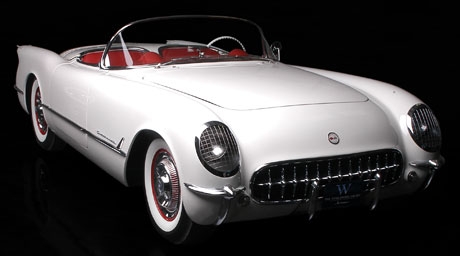The Corvette was introduced at the General Motors Motorama at the Waldorf-Astoria hotel in New York and it was a sensation. Its two-seater body was wrapped around the conventional perimeter frame chassis with independent front suspension and live rear axle. The body itself was a revelation, constructed from a revolutionary material called fiberglass that was only beginning to establish its reputation for light weight, strength, and efficient low-volume manufacturing.
It was powered by Chevy’s proven overhead valve inline 6-cylinder engine. Fitted with three single-throat, side-draft Carter carburetors, mechanical lifters, 8:1 compression, split exhaust manifold and dual exhaust pipes, it made 150 hp and drove through Chevy’s 2-speed Powerglide automatic transmission.
The 1953 Corvette offered here is number 120. It has been lovingly and carefully restored with special attention to preserving many of its most unique individual features and markings that are characteristic of the earliest Corvettes. The original Blue Flame Special engine, LAY512502, has been removed and is preserved in carefully restored condition on a rolling engine stand. Many of the original markings put on the Corvette’s parts by vendors and the Flint line have been discovered and protected during its restoration. These include number 120 written on one of the headlight buckets, a rubber-stamped date above the driver’s door post, and red ink markings on the driver’s side door pillar.
A 1953 Corvette is a rare and highly desirable addition to any collection, but a 1953 Corvette with originality, history, and careful preservation is almost never available for public sale.
SCM Analysis
Detailing
| Vehicle: | 1953 Chevrolet Corvette Roadster |
| Years Produced: | 1953 |
| Number Produced: | 300 |
| Original List Price: | $3,498 |
| SCM Valuation: | $250,000–$350,000 |
| Tune Up Cost: | $300 |
| Distributor Caps: | $25 |
| Chassis Number Location: | Driver's side door post |
| Engine Number Location: | Stamped on machined pad rear of distributor |
| Club Info: | National Corvette Owners Assoc. P.O. Box 777A Falls Church, VA 22046 |
| Website: | www.ncoa-vettes.com |
| Alternatives: | 1951-54 Jaguar XK120 1954 Kaiser Darrin 1951-54 Nash-Healey |
| Investment Grade: | B |
This car sold for $396,000 at the Worldwide Group’s Houston Classic auction held at Seabrook, Texas, on May 5, 2007. Harley Earl’s interest in sportier two-seater cars was apparent in his dream cars of the early 1950s. The LeSabre of 1951 and the Buick XP-300 that was shown a year later featured a wraparound windshield, a toothy oval grille, and a low sports car stance. A low-priced sporty car was definitely in the works. Apart from its fiberglass body, the car (code named “Project Opal”) used off-the-shelf parts. It met with the approval of GM President Harlow Curtice and Chevrolet Division GM Thomas Keating and was presented at the 1953 Motorama. The Corvette was a resounding success, and after a few hectic months, full production began in a temporary facility in Flint, Michigan, in June 1953.
300 Corvettes hand-built
Chevrolet manufactured only 300 hand-built Corvettes for 1953 and they were carefully placed with handpicked celebrities in order to gain maximum exposure. Briggs Cunningham bought one for his wife. John Wayne wanted one, but found the Corvette too small for him. The striking styling aside, the Corvette could not find its niche with the general public. Fish or fowl? Boulevard cruiser or European-style sports car? Neither side flocked to the car. The awkward side curtains, clumsy inside door latch, and poor water sealing made it a tough sell to the former, and the latter scoffed at the thought of a 2-speed automatic and anemic 6-cylinder engine in a sports car. Furthermore, all 300 came with AM radios and heater, which pushed the list price to $3,734, compared to the selling price of $3,345 for the Jaguar XK 120. As a result, production for the following year, which moved to St. Louis, was scaled back from the projected run of 10,000 and the decision to switch to steel bodies was delayed. Few would argue with the idea that while the early C1s were styled with an appealing and attractive body, the build quality was marginal at best, and the performance with the Blue Flame Six was disappointing. That said, how do we justify the $396,000 that was paid here? We have several other recent sales of 1953 Corvettes to further confuse our analysis. Two were sold at the June 15–17 Mecum Bloomington sale, with #107 making $296,625 and #210 selling for $283,500. Based on these sales we can easily conclude that someone got a little carried away to the tune of $100,000 or so at the Houston Classic. But then look at the sale of #157, which sold for $440,000 at the recent RM Ponder sale, while the #003 Corvette sold at Barrett-Jackson in January 2006 for $1,080,000.
Muddying the waters
To further muddy the waters, this actual car sold for $212,000 (CM# 41422) at the April 2006 Branson auction, with the Sports Car Market analysis stating that “…this car was well bought and sold with possibly a small amount of movement left.” The seller here obviously made a handsome profit for his 13-month ownership, but does the new owner have anywhere to go from here? Even as the early Corvettes continue to reach new high-water marks on the value charts, it’s hard to imagine 1953s consistently selling in this range. The Mecum sales appear to be more the rule and this and the Ponder sale the exception. So overall, this auction result should be considered a very good one indeed, for the seller.
